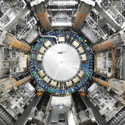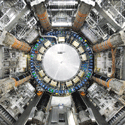Leveraging the LHC advantage in energy
With its tera-electron-volt ( ) collisions, the Large Hadron Collider (LHC) at CERN is unmatched in energy. But the Fermilab Tevatron is, for the moment, still far more intense, has operated far longer, and so has recorded many more events than the LHC. In order for the LHC to compete with Fermilab with just a few months of data, it must look for signals that are enhanced by the higher energy available at the LHC, such as those from new particles that are copiously produced above an energy threshold.
The ATLAS Collaboration at the LHC, which consists of over researchers from institutions in countries, has done exactly that with a search for new strongly interacting particles in the production of a pair of jets (dijets). They look for “bumps” in the mass distribution of the dijets, which could arise in a number of models beyond the standard model. Seeing none, they are able to place general bounds on such theories, and a specific lower bound on the mass of one particular type of new particle called an “excited quark.” The bound, , supersedes the Fermilab bound of .
This is the first time the LHC has bettered a Fermilab bound, and they have done so with about times less data, attesting to the leveraging power of the LHC’s higher energy. Further, the LHC’s event total is growing exponentially, so it will not be long before many new constraints, and hopefully some signals of new physics, start rolling in. – Robert Garisto





